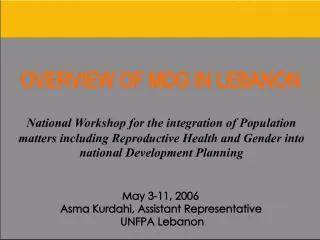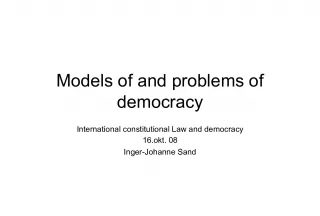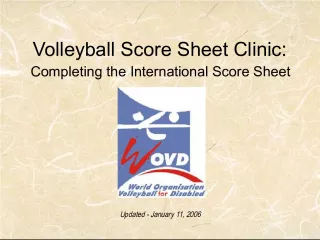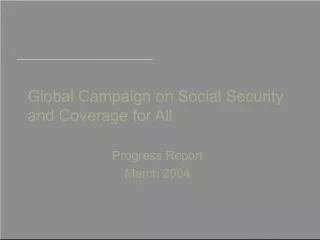Measures of progress in international development


This presentation explores different indicators of progress in international development, from traditional GDP to sustainable development indicators. It also examines the World Bank's classification of economies based on gross national income per capita. Lessons from Millennium Development Goals inform the post-2015 development agenda.
- Uploaded on | 3 Views
-
 danielle
danielle
About Measures of progress in international development
PowerPoint presentation about 'Measures of progress in international development'. This presentation describes the topic on This presentation explores different indicators of progress in international development, from traditional GDP to sustainable development indicators. It also examines the World Bank's classification of economies based on gross national income per capita. Lessons from Millennium Development Goals inform the post-2015 development agenda.. The key topics included in this slideshow are . Download this presentation absolutely free.
Presentation Transcript
1. Measures of progress in international development RSS 2013 Conference Neil Jackson, Chief Statistician Department for International development
2. Measures of progress in international development • From GDP to sustainable development indicators • The Millennium Development Goals • Lessons for the Post-2015 development agenda
3. World Bank classification of economies 2012 Gross National Income per Capita (World Bank Atlas method) • Low income: $1,035 or less • Lower middle income: $1,036 to $4,085 • Upper middle income: $4,086 to $12,615 • High income: $12,616 or more
5. Report by the Commission on the Measurement of Economic Performance and Social Progress; 2009 Professor Joseph E. STIGLITZ, Chair, Columbia University Professor Amartya SEN, Chair Adviser, Harvard University Professor Jean-Paul FITOUSSI, Coordinator of the Commission, IEP
6. Multi-dimensional aspects of current well-being i. Material living standards (income, consumption and wealth); ii. Health; iii. Education; iv. Personal activities including work v. Political voice and governance; vi. Social connections and relationships; vii. Environment (present and future conditions); viii. Insecurity, of an economic as well as a physical nature.
7. The Millennium Development Goals
8. Extract from High level Report Term How it is used in this report Example from MDGs Goal Expresses an ambitious, but specific, commitment. Always starts with a verb/action. Reduce child mortality Targets Quantified sub-components that will contribute in a major way to achievement of goal. Should be an outcome variable. Reduce by two-thirds, between 1990 and 2015, the under-five mortality rate Indicators Precise metric from identified databases to assess if target is being met (often multiple indicators are used). Proportion of 1-year olds immunized against measles
9. GOAL 1: ERADICATE EXTREME POVERTY & HUNGER Target 1.A: Halve, between 1990 and 2015, the proportion of people whose income is less than $1 a day Indicators for monitoring progress 1.1 Proportion of population below $1 (PPP) per day 1.2 Poverty gap ratio 1.3 Share of poorest quintile in national consumption
10. GOAL 1: ERADICATE EXTREME POVERTY & HUNGER 1990 1999 2005 2010 Developing Regions 46.7 36.5 26.9 22.0 Target 1.A: Halve, between 1990 and 2015, the proportion of people whose income is less than $1 ($1.25) a day Indicator 1.1 Proportion of population below $1 (PPP) per day (percentage)
12. GOAL 1: ERADICATE EXTREME POVERTY & HUNGER Target 1.A: Halve, between 1990 and 2015, the proportion of people whose income is less than $1.25 a day Indicator 1.2 Poverty gap ratio – incidence multiplied by depth of poverty; (percentage) 1990 1999 2010 Developing Regions 16.1 11.9 6.8
13. GOAL 1: ERADICATE EXTREME POVERTY & HUNGER Target 1.A: Halve, between 1990 and 2015, the proportion of people whose income is less than $1.25 a day Indicator 1.3 Share of poorest quintile in national consumption No global or regional data are available
14. IAEG: Lessons learned from MDG Monitoring • Targets and indicators perceived as “top down” • The baseline year was set too far away from the adoption of the framework • Confusion over whether the targets were global or national
15. Some goals, targets and indicators are not well- aligned GOAL 3: Promote gender equality and empower women Target 3.A: Eliminate gender disparity in primary and secondary education, preferably by 2005, and in all levels of education no later than 2015 Indicator 3.3 Proportion of seats held by women in national parliament
16. Some targets lack clear numerical yardsticks, and are ambiguous and vague Goal 1: Eradicate extreme poverty and hunger Target 1.B: Achieve full and productive employment and decent work for all, including women and young people Goal 5: Improve maternal health Target 5.B: Achieve, by 2015, universal access to reproductive health
17. Illustrative Goals from the High Level Panel Report 1 End poverty 2 Empower Girls and Women and Achieve Gender Equality 3 Provide Quality Education and Lifelong Learning 4 Ensure Healthy Lives 5 Ensure Food Security and Good Nutrition 6 Achieve Universal Access to Water and sanitation 7 Secure Sustainable Energy 8 Create Jobs, Sustainable Livelihoods, and Equitable Growth 9 Manage natural resources sustainably 10 Ensure Good Governance and Effective Institutions 11 Ensure Stable and Peaceful Societies 12 Create a Global Enabling Environment and Catalyse Long-Term Finance
19. GOAL 1: ERADICATE EXTREME POVERTY & HUNGER Target 1.A: Halve, between 1990 and 2015, the proportion of people whose income is less than $1 a day Target 1.B: Achieve full and productive employment and decent work for all, including women and young people Target 1.C: Halve, between 1990 and 2015, the proportion of people who suffer from hunger























